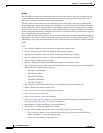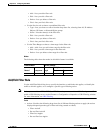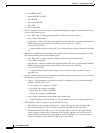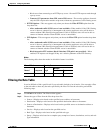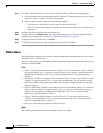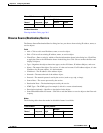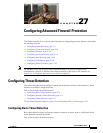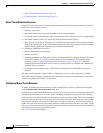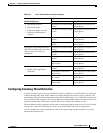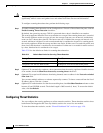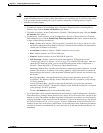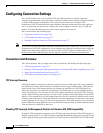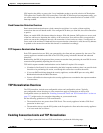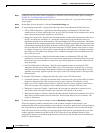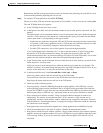
27-2
Cisco ASDM User Guide
OL-16647-01
Chapter 27 Configuring Advanced Firewall Protection
Configuring Threat Detection
• Basic Threat Detection Overview, page 27-2
• Configuring Basic Threat Detection, page 27-2
Basic Threat Detection Overview
Using basic threat detection, the security appliance monitors the rate of dropped packets and security
events due to the following reasons:
• Denial by access lists
• Bad packet format (such as invalid-ip-header or invalid-tcp-hdr-length)
• Connection limits exceeded (both system-wide resource limits, and limits set in the configuration)
• DoS attack detected (such as an invalid SPI, Stateful Firewall check failure)
• Basic firewall checks failed (This option is a combined rate that includes all firewall-related packet
drops in this bulleted list. It does not include non-firewall-related drops such as interface overload,
packets failed at application inspection, and scanning attack detected.)
• Suspicious ICMP packets detected
• Packets failed application inspection
• Interface overload
• Scanning attack detected (This option monitors scanning attacks; for example, the first TCP packet
is not a SYN packet, or the TCP connection failed the 3-way handshake. Full scanning threat
detection (see the “Configuring Scanning Threat Detection” section on page 27-3) takes this
scanning attack rate information and acts on it by classifying hosts as attackers and automatically
shunning them, for example.)
• Incomplete session detection such as TCP SYN attack detected or no data UDP session attack
detected
When the security appliance detects a threat, it immediately sends a system log message (730100).
Basic threat detection affects performance only when there are drops or potential threats; even in this
scenario, the performance impact is insignificant.
Configuring Basic Threat Detection
To enable or disable basic threat detection, on the Configuration > Firewall > Threat Detection pane,
click the Enable Basic Threat Detection check box.
By default, this option enables detection for certain types of security events, including packet drops and
incomplete session detections. You can override the default settings for each type of event if desired.
If an event rate is exceeded, then the security appliance sends a system message. The security appliance
tracks two types of rates: the average event rate over an interval, and the burst event rate over a shorter
burst interval. The burst rate interval is 1/60th of the average rate interval or 10 seconds, whichever is
higher. For each received event, the security appliance checks the average and burst rate limits; if both
rates are exceeded, then the security appliance sends two separate system messages, with a maximum of
one message for each rate type per burst period.
Table 27-1 lists the default settings.



